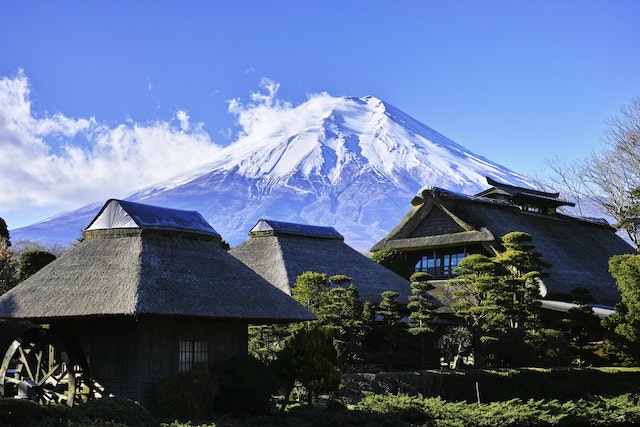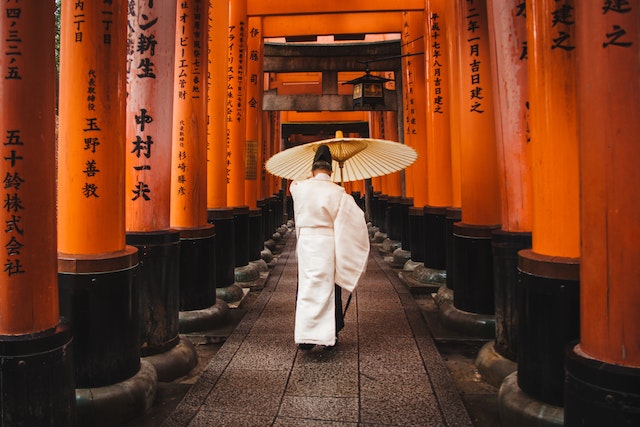
Japanese mythology is the body of traditional stories, beliefs, and customs associated with the history, religion, and culture of Japan.
It has heavily influenced both Shinto and Buddhist practices as well as literature and art throughout the country’s history.
It is a vast collection of stories that range from creation myths to warring gods, ancient heroes to magical creatures, and much more.
Here are some facts about Japanese mythology to get you started on exploring this fascinating world.
Fact #1: Izanagi and Izanami are the Japanese Creators.
Izanagi and Izanami are the two major gods in Japanese mythology.
They are described as siblings who were tasked by their parents to create a world from primordial chaos.
Together they descended into the chaotic abyss and stirred it with a spear to form an islet, which became the first land of Japan.
Working together, they then created the gods of the universe and gave them various roles to fill.
The two deities also created islands, mountains, rivers, and seas, forming Japan as we know it today.
Izanagi and Izanami are considered the primary creators of Japan, giving rise to a long line of divinities that would come after them.
- Read also: 10 Fascinating Egyptian Mythology Facts
- Read also: Top 10 Sumerian Mythology Facts
Fact #2: Japan’s gods are divided into two groups.
The gods of Japanese mythology are divided into two main groups: the Kami and the Yōkai.
The Kami are divine spirits who control natural forces such as the sun, wind, rain, and thunder.
They were often seen as benevolent figures that provided protection to humans and could grant them power or blessings when asked. Examples of well-known Kami include Amaterasu, the sun goddess; Inari, the god of fertility and agriculture; and Raijin, the god of thunder.
The Yōkai are supernatural creatures or phenomena whose origins and forms vary greatly. These can range from benevolent nature spirits to mischievous monsters that cause trouble for humans.
Fact #3: The Sun Goddess is Japan’s most important deity.

The Sun Goddess, Amaterasu, is the most important deity in Japanese mythology.
According to legend, she was born out of Izanagi and Izanami’s union when they created Japan.
As the sun goddess, she is responsible for bringing light and warmth to the universe and ensuring the world continues to exist.
She is also seen as a symbol of rebirth and renewal, as the sun always rises again after it sets.
Amaterasu is worshipped in many Shinto shrines across Japan, where she is seen as a symbol of peace, love, and harmony.
Fact #4: Many Japanese gods are associated with animals.
Many deities in Japanese mythology have associations with different animals.
For example, Inari, the god of fertility and agriculture, is often depicted with foxes or a fox mask.
Raijin, the god of thunder and lightning, is usually depicted as a demon with drums that he uses to create thunder.
The kitsune—or fox spirit—is also an important figure in Japanese mythology and is often seen as a mischievous but protective creature.
Fact #5: Japanese mythology is filled with heroes and villains.
Japanese mythology has its fair share of heroes and villains, often in the form of gods or legendary figures.
Some famous hero figures include:
- Yamato Takeru: a warrior prince who conquered his enemies with his strength and courage
- Momotaro: a boy born from a peach pit who went on to defeat evil demons
- Princess Kaguya: a celestial being who came to Earth as a baby and grew up to save her people.
On the other hand, villains like Orochi—an eight-headed dragon with immense power—and Oni—evil ogre-like creatures that terrorize humans—are also featured prominently in Japanese mythology.
These characters often symbolize the struggle between good and evil, a theme that is central to many myths around the world.
Fact #6: Japanese mythology is often intertwined with Shinto beliefs.
Shintoism is an ancient belief system native to Japan that focuses on worshipping various gods, spirits, and nature.
It is closely intertwined with Japanese mythology, as many of the gods and creatures in myths are seen as sacred by Shinto practitioners.
Shinto rituals such as offerings, prayers, and ceremonies are often used to honor the gods or ask for blessings.
Some of the most important shrines in Japan—such as the Ise Grand Shrine dedicated to Amaterasu—are associated with Shinto beliefs.
Fact #7: Japanese mythology continues to influence modern culture.
The gods and creatures of Japanese mythology continue to be a source of inspiration for many forms of art and entertainment today.
From anime and manga series that feature classic mythological figures to video games like Okami, in which one plays as the sun goddess Amaterasu, these myths have had a lasting impact on modern culture.
Fact #8: Japanese mythology can provide comfort and hope.
While the tales of ancient gods and monsters may seem fantastical, they often contain timeless lessons that can be applied to everyday life.
For example, many myths focus on themes such as bravery, compassion, and perseverance—all important qualities that help us navigate our lives.
In times of hardship or loss, the stories of Japanese mythology can provide comfort and hope. They remind us that no matter how difficult our situation might be, we can still find strength in ourselves and rise again.
Fact #9: Japanese mythology is still evolving.

Despite its ancient roots, Japanese mythology continues to evolve and grow even today.
As the culture changes, so do the gods, stories, and beliefs that make up this fascinating mythological world.
From new interpretations of classic tales to entirely original creations, Japanese mythology remains as vibrant and alive as ever—a testament to its enduring power and relevance.
- Read also: 10 Fascinating Ancient History Facts
- Read also: The Most Impactful American History Events
Fact #10: Susanoo, is known for his tempestuous and violent nature, but is also a protector of mankind
The god of war and thunder, Susanoo, is a major figure in Japanese mythology and is known for his tempestuous and violent nature.
He is the brother of the sun goddess Amaterasu and is said to have been born from the nose of the god Izanagi.
According to one legend, Susanoo causes chaos in the heavens and is eventually banished from the world of the gods by his sister, Amaterasu.
He then descends to the mortal world, where he has many adventures and battles with monsters and dragons, and eventually becomes the protector of mankind.
Despite his brutal nature, Susanoo is also a protector of mankind and is said to have rescued a goddess from a dragon and helped to create the first rice fields in Japan.
He is also credited with having given a sword to the first emperor of Japan, Jimmu, which is said to be the sword that was used to unite Japan.
He is honored in many shrines, especially in the area of Japan that is prone to natural disasters, as a god of protection.
Overall, Japanese mythology is an expansive and captivating field of study that spans generations.
From its ancient gods and monsters to its modern reinterpretations, it contains a wealth of stories and lessons that will continue to inspire us for years to come.
By exploring these myths, we get a unique glimpse into the history, culture, and beliefs of the Japanese people—allowing us to appreciate the beauty of this ancient tradition.



